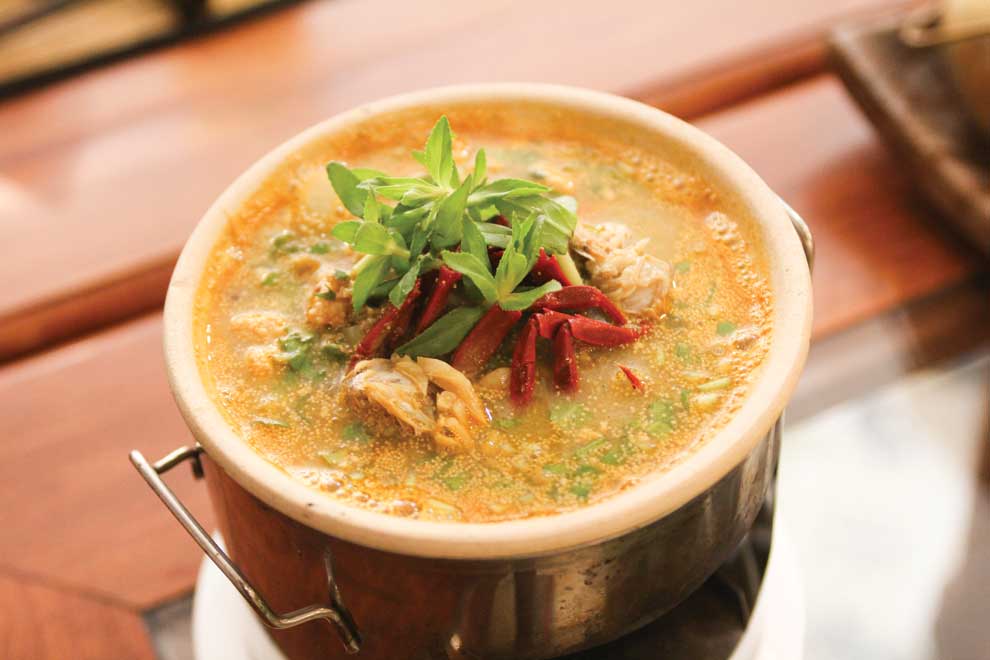
A bowl of the crab soup, a delicacy from Kampot.
Ly San has an unusual mission for a law student: promoting authentic Khmer cuisine and studying its roots.
For six years, he travelled the country exploring its culinary traditions and brought back the recipes to a small restaurant he co-owns with two friends on Street 63 in Boeung Keng Kang 1 called Kraya Angkor.
Born in Siem Reap, San was motivated by what he saw as a lack of familiarity among his own people of the country’s native cuisine.
“I have been abroad and tasted foreign dishes, which are well-known all around the world,” he says. “On the other hand, many Khmer dishes are not even familiar among Cambodian people.”
Civil war and genocide, according to San, virtually wiped out many of the country’s original recipes. But he believed the culinary secrets lived on with the survivors, despite a lack of documentation.

Meang Kham, a dish from the Royal Court cuisine that is best eaten by putting a bit of everything on one of the cone-shaped leaves.Sahiba Chawdhary
San began travelling all over the country in 2011 to search for the missing recipes. He started with his hometown, in which he interviewed dozens of elderly Cambodians, from 65 to 85 years old, about the Khmer dishes they grew up with and asked them to show him how they prepared them. He also discovered a certain hierarchy of foods by speaking with relatives and friends who used to work in the Royal Palace.
“Apart from discovering many missing recipes, I found that ancient Khmer cuisine was divided into three categories – royal court cuisine, elite cuisine and peasant cuisine,” he says. The royal court cuisine was the top of the list, with high-end ingredients and unique recipes that could not be found anywhere outside the Royal Palace. The other two are similar in terms of recipes, but different in ingredients.
“The elite cuisine was usually for the officials and the wealthy, served by their cooks, and with the second-best ingredients, while the peasant cuisine was the core of ordinary people’s diets, using simple ingredients they could find in their areas,” he explains. “For example, both cuisines comprise Trey Ang [grilled fish] with mango salad, but the elite would get the big fish from the Mekong River while the peasants would eat the fish they caught in the local pond.”

Ly San, is the co-owner and General Manager of the restaurant traveled for six years to study the traditional cuisine.Sahiba Chawdhary
All three of these food groups are on offer at Kraya Angkor, which opened last year.
Those who want to try dishes normally reserved for kings and courtiers can start with Na Tang ($4.50), an appetiser consisting of the deep-fried sticky rice with gravy made of minced pork, dried chili and coconut milk. Then they can go to the main course, Meang Kham ($6.50), which comprises a small bowl of Kapi (Cambodian shrimp paste), served together with dried shrimp, smoked fish, and various vegetables such as Kamploo leaves, string beans, cucumbers and orange peels.
The proper way to handle it is by putting a bit of everything on one of the cone-shaped leaves and eating with one’s hands.
Kraya Angkor also offers more well-known staples, such as Fish Amok ($6.50), whose ingredients include the leaves from Nhor, a kind of rattan in Cambodia, which are hard to find and thus not used in many restaurants. Kraya Angkor also offers regional specialties such as Crane Prahok ($6.25), a dish of roasted Cambodian pork paste from Siem Reap, Khor Kola ($5.25), the caramelised pork originating from the Kola ethnic group in Pailin and Crab Soup ($5.25) from Kampot.

Fish Amok, an iconic dish of Khmer cuisine.Sahiba Chawdhary
To ensure freshness and adjust to seasonal variation of the ingredients, the restaurant deals directly with farmers in Siem Reap, Prey Veng and Svay Rieng. Meanwhile, Kraya Angkor’s menu is also adjusted in accordance with the seasons.
On top of his other work, San has finished a book about Cambodian cuisine and his quest to bring back the lost recipes, which he hopes will be published soon in Khmer and English after finding a translator.
Kraya Angkor is located at #60BEo Street 63, Boeung Keng Kang. It is open every day from 10am-10pm.
Contact PhnomPenh Post for full article
Post Media Co LtdThe Elements Condominium, Level 7
Hun Sen Boulevard
Phum Tuol Roka III
Sangkat Chak Angre Krom, Khan Meanchey
12353 Phnom Penh
Cambodia
Telegram: 092 555 741
Email: [email protected]









